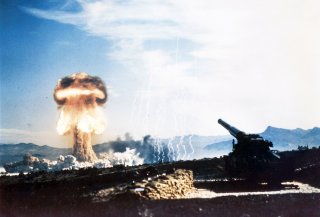Are the U.S. Army and DARPA Trying to Start a Nuclear Arms Race?
Why the army could be opening the ultimate pandora's box.
Could new U.S. tactical missile projects trigger a new nuclear arms race?
Recent comments by U.S. Army leaders, and a new project from Pentagon research agency DARPA, point to the United States developing new long-range battlefield missiles.
The Pentagon believes that it needs the missiles because its field artillery is inferior to Russian guns that have a longer range than their American counterparts. “We need cannons that fire as far as rockets today, we need rockets that fire as far as missiles, and we need missiles that push out to 499 kilometers and beyond," Gen. Robert Brown, commander of U.S. Army Pacific, told an Association of the U.S. Army audience in Huntsville, Alabama last month.
"499 kilometers and beyond" is a very significant phrase, because the 1987 Intermediate Range Nuclear Force Treaty (INF), signed by Ronald Reagan and Mikhail Gorbachev, banned nuclear and conventional missiles with a range of 500 to 5,500 kilometers (or about 300 to 3,400 miles). The agreement came in the midst of an arms race after the Soviets deployed SS-20 intermediate-range nuclear missiles which threatened Western Europe, to which the United States responded by deploying Pershing II and ground-launched cruise missiles.
Recommended: How Israel Takes U.S. Weapons and Makes Them Better.
Recommended: North Korea’s Most Lethal Weapon Isn’t Nukes.
Recommended: 5 Worst Guns Ever Made.
The conventional weapons provision pointed to an uncomfortable fact: there is no way to peek inside a nose cone to be sure the missile isn't carrying a nuclear warhead. So while conventional intermediate-range missiles could have many uses (attacking airfields, command centers, etc.), a missile launched from, say, Germany could hit Moscow with a nuclear weapon.
Indeed, the INF treaty obligated both sides to dismantle a lot of expensive hardware: 2,692 weapons, from short-range tactical missiles to long-range cruise missiles. It also established mechanisms for both sides to verify compliance. The treaty has been assailed in recent years, with the United States accusing Russia of violating the agreement by deploying a new ground-launched cruise missile. Putin's recent speech, in which he boasted of Russia developing a nuclear-powered cruise missile, isn't likely to reduce tensions.
However, General Brown suggested that the U.S. Army wouldn't mind breaching the INF treaty. “‘I know there’s the INF treaty...but we need to push beyond that,’” Brown said, according to Politico.
At the same time, DARPA is pursuing its OpFires missile program. "The United States ground-based forces are currently limited in effective range of surface-to-surface precision fires," according to DARPA. "The OpFires program seeks to provide operational/theater level commanders with flexible capabilities to strike time sensitive targets while providing persistent standoff from unpredictable land launch positions."
DARPA says "the overarching goal of the OpFires program is to develop and demonstrate a novel ground-launched system enabling advanced tactical weapons to penetrate modern enemy air defenses and rapidly and precisely engage critical time sensitive targets."
The range and capabilities of OpFires were not specified in the unclassified documentation, and DARPA did not respond to queries about the project. The proposal does mention that DARPA is seeking booster and propulsion technology appropriate for a "large tactical missile." These missiles would be under the control of "operational/theater level commanders," suggesting a missile that's more than short range. Whether this indicates a range that will test the INF Treaty limits is unknown.
Then again, perhaps what will really matter is whether the Russians believe that these weapons are not a violation.
It must be said that there is nothing inherently wrong with the U.S. military seeking long-range weapons in the face of a potential Russian adversary armed with artillery of superior range. Indeed, given that artillery has historically been perhaps the strongest arm of Russian ground forces (Stalin called artillery "the God of War"), it's no surprise the United States would want its own powerful artillery.
However, the fact remains that the existence of both missiles and nuclear weapons is a difficult mix. Hence the controversy a decade ago over the Prompt Global Strike concept, which would have placed conventional warheads on Minuteman and Trident ICBMs for a quick-strike capability. It's why hypersonic missiles are a hot button issue, because even if those weapons aren't supposed to carry nukes, their speed and maneuverability could make them formidable nuclear missiles.
I asked arms control expert James Acton, who has studied the problem of "nuclear entanglement," when the line blurs between nuclear and conventional weapons, such as when conventional missiles can be used to destroy an opponent's nuclear missiles.
"In terms of entanglement, the question would be whether this weapon could plausibly threaten Russian nuclear missile silos, mobile launchers, command and control and so on," Acton replied. “Difficult to judge that right now. DARPA mentions time-sensitive targets, and mobile launchers could fall under this description. Whether this weapon could threaten such launchers depends on various factors: its deployment location, range, the U.S. ability to track mobile target, command and control arrangements etc.”
"I guess that in general, I think the range of this weapon [OpFires] may be too short to have major entanglement concerns," Acton added. "But it certainly bears watching."
Michael Peck is a contributing writer for the National Interest. He can be found on Twitter and Facebook.
Image: Wikimedia Commons
Recommended:
Why North Korea's Air Force is Total Junk

